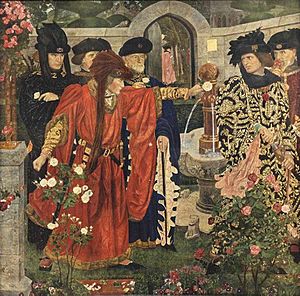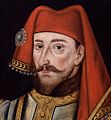Wars of the Roses facts for kids
The Wars of the Roses were a series of civil wars fought in England between 1455 and 1487. These wars were about who should be the King of England. Two powerful families, the House of Lancaster (Lancastrians) and the House of York (Yorkists), fought for control. Both families were part of the larger Plantagenet royal family. They were related through King Edward III.
The wars started for several reasons. Many people thought King Henry VI was a weak ruler. He was not very interested in politics and had an illness that affected his mind. His French wife, Queen Margaret of Anjou, often made important decisions instead. England had also just lost the Hundred Years' War in France. This caused money problems and issues with the way the government was run.
The name "Wars of the Roses" comes from the symbols used by each side. The House of York used a white rose, and the House of Lancaster used a red rose. However, the red rose symbol was not widely used until after the wars ended. Most soldiers fought under the symbol of their local noble leader. The name "Wars of the Roses" was not used until the 1800s. Before that, people called them the "Civil Wars." The families were named after the cities of Lancaster and York, but these cities did not play a big role in the fighting. The two families owned land all over England and Wales.
Contents
Why the Wars Started
King Edward III had many sons. His oldest son, known as "The Black Prince," died before his father. So, the throne went to the Black Prince's son, Richard. He became King Richard II of England in 1377 when he was only ten years old.
Richard II grew up to be a king that many people did not like. He even sent his cousin Henry into exile. Henry later came back to England while Richard was away in Ireland. Henry took control of the country. When Richard returned, Henry tricked him and put him in prison, where Richard later died. Henry then became King Henry IV of England.
Henry IV ruled until he died. His son, King Henry V, became king in 1413. The next king, Henry VI, was only a baby when he was crowned in 1422. King Henry VI ruled for many years. But some people thought he was a poor ruler. This was because he was not interested in politics and had an ongoing illness that affected his mind. His French queen, Margaret of Anjou, became very powerful.
In 1453, King Henry VI's illness made him unable to run the country. A powerful nobleman named Richard, Duke of York, convinced other nobles to make him "Lord Protector." This meant he would rule the country until the king got better. Henry recovered in 1455. Queen Margaret then convinced Henry to remove York from power. York became worried that the king would have him killed.
The War Begins
First Battles (1455)
Richard, Duke of York, decided he needed to fight the king to protect himself. He gathered an army of people who were unhappy with Henry and Margaret. This led to the First Battle of St Albans in 1455. It was the first battle between the Yorkists (who supported York) and the Lancastrians (who supported Henry).
York won the battle with help from the Earl of Warwick. King Henry was found hiding and was taken prisoner. He became ill again. Some of his main supporters were killed in the battle. York was made Lord Protector once more.
The next year, Henry recovered. York allowed him to rule the country again and was put in charge of Ireland. Henry and Margaret knew they could not easily get rid of Richard. For a few years, both sides tried to avoid another war. But they could not agree on important things. York wanted to be the next king after Henry died, instead of Henry and Margaret's newborn son, Edward. Margaret would not agree to this. Henry moved to Coventry, where he had more support.
Major Fighting (1459-1461)
A more serious war started in 1459. It began because the Earl of Warwick, who was in charge of Calais, had attacked ships from other countries. King Henry asked Warwick to explain his actions, but Warwick refused. Soon, York and Warwick began to gather an army. They were defeated at the Battle of Ludford Bridge and had to flee England. Henry and the Lancastrians were now in control. They ordered that York and Warwick be killed if found.
This did not last long. York and Warwick returned and raised another army. They won the Battle of Northampton. For the second time, King Henry was captured after becoming ill. York was made Lord Protector for a third time. York then announced that he wanted to become king himself. Many of his supporters thought this was too much. So, they agreed that Henry would remain king, but York (not Henry's son) would be the next king.
York then went to northern England to fight the remaining Lancastrians. This led to a disaster. York lost the Battle of Wakefield at the end of 1460 and was killed. His son, Edward, became the new leader of the Yorkists. The next year had mixed results for both sides. Edward defeated a Lancastrian army at the Battle of Mortimer's Cross. But the Lancastrians won the Second Battle of St Albans, where Henry escaped. In London, Edward received a lot of support. He announced he wanted to take the throne. He then defeated the Lancastrians at the Battle of Towton. This was the bloodiest battle ever fought on British soil.
After Towton, Edward was in control of England. He was crowned as Edward IV in June 1461. Over the next few years, he and his allies stopped small Lancastrian rebellions. Henry was captured again in 1465.
Warwick Changes Sides (1469-1471)
Fighting started again in 1469 when Edward's most powerful supporter, the Earl of Warwick, switched sides. Warwick was very angry that Edward had married Elizabeth Woodville, a woman who was not from a noble family. Many people also thought this was wrong. At that time, kings were expected to marry daughters of noblemen or other kings. Warwick led a rebellion against the king. The country was in chaos. At one point, Warwick captured Edward, meaning he had captured two kings. He soon let Edward go.
Warwick then supported making Henry king again. He believed he could rule the country while Henry was on the throne. He also arranged for Henry's son to marry Warwick's daughter, Anne Neville. Edward could not gather an army to fight, so he fled the country in 1470. Henry VI then became the ruler again. Warwick's role in bringing Edward and then Henry to power earned him the nickname "Kingmaker."
Henry's return did not last long. Warwick planned to help France invade Burgundy. So, Burgundy helped Edward find soldiers. Edward returned in 1471. He then won two big victories against the Lancastrians. The first was the Battle of Barnet, where Warwick was killed. The second was the Battle of Tewkesbury, where Margaret was taken prisoner and her son was killed. Edward IV took the throne again. Henry VI died soon afterward. Historians think Edward had him killed. This left the Lancastrians without a leader. There was little fighting for the next 12 years. Margaret was released in 1475 and went back to France. She died in 1482.
Richard III (1483-1485)
Edward IV ruled until his sudden death in 1483. Before he died, Edward said that his 12-year-old son, Edward V, should become king. Edward's brother, Richard, would be "Lord Protector." Richard would run the country until Edward V became an adult.
Edward V was king for 78 days before Richard took the throne for himself. He was crowned as Richard III. The young Edward and his brother disappeared a few months later while living in the Tower of London. Many people believed Richard had ordered the boys to be killed. This caused many Yorkists to turn against Richard III.
Richard managed to win against a rebellion led by his old friend, the Duke of Buckingham. Then, Henry Tudor, a distant relative of Henry VI, returned to England. He became the leader of the rebellions, creating a new Lancastrian army. In the Battle of Bosworth Field, Richard III was killed, and his army was defeated. Henry took the throne as King Henry VII. He was the first king of the House of Tudor.
After the Wars
The Battle of Bosworth Field is often seen as the end of the Wars of the Roses. However, there was another big battle two years later when Henry VII stopped a rebellion. Despite this, Henry was able to bring peace to the country.
Henry told people that he was bringing the two families together. To show this, he married Edward IV's daughter, Elizabeth of York. He also created the Tudor rose symbol, which joined a red rose and a white rose together.
Images for kids
-
19th century engraving of the apocryphal scene in the Temple Garden, from Shakespeare's play "Henry VI Part 1", where supporters of the rival factions pick either red or white roses
-
A near-contemporary Flemish picture of the Battle of Barnet in 1471
-
Anne Mortimer's husband Richard, Earl of Cambridge
-
Ludlow Castle, South Shropshire
-
Ruins of Sandal Castle, near Wakefield, West Yorkshire
-
Harlech Castle, Gwynedd, Wales
-
Princes in the Tower, painted by John Everett Millais
See also
 In Spanish: Guerra de las Dos Rosas para niños
In Spanish: Guerra de las Dos Rosas para niños






















